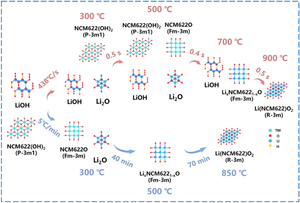Nano-Micro Letters ( IF 31.6 ) Pub Date : 2024-06-06 , DOI: 10.1007/s40820-024-01436-y Zhedong Liu , Jingchao Zhang , Jiawei Luo , Zhaoxin Guo , Haoran Jiang , Zekun Li , Yuhang Liu , Zijing Song , Rui Liu , Wei-Di Liu , Wenbin Hu , Yanan Chen

|
Nickel-rich layered oxide LiNixCoyMnzO2 (NCM, x + y + z = 1) is the most promising cathode material for high-energy lithium-ion batteries. However, conventional synthesis methods are limited by the slow heating rate, sluggish reaction dynamics, high energy consumption, and long reaction time. To overcome these challenges, we first employed a high-temperature shock (HTS) strategy for fast synthesis of the NCM, and the approaching ultimate reaction rate of solid phase transition is deeply investigated for the first time. In the HTS process, ultrafast average reaction rate of phase transition from Ni0.6Co0.2Mn0.2(OH)2 to Li- containing oxides is 66.7 (% s−1), that is, taking only 1.5 s. An ultrahigh heating rate leads to fast reaction kinetics, which induces the rapid phase transition of NCM cathodes. The HTS-synthesized nickel-rich layered oxides perform good cycling performances (94% for NCM523, 94% for NCM622, and 80% for NCM811 after 200 cycles at 4.3 V). These findings might also assist to pave the way for preparing effectively Ni-rich layered oxides for lithium-ion batteries.
中文翻译:

接近锂离子电池富镍层状正极的最终合成反应速率
富镍层状氧化物LiNi x Co y Mn z O 2 (NCM,x + y + z = 1)是最有前途的高能锂离子电池正极材料。然而,传统的合成方法受到加热速率慢、反应动力学缓慢、能耗高和反应时间长的限制。为了克服这些挑战,我们首先采用高温冲击(HTS)策略来快速合成NCM,并首次深入研究了接近最终的固相转变反应速率。在高温超导过程中,从Ni 0.6 Co 0.2 Mn 0.2 (OH) 2 到Li-的相变超快平均反应速率含氧化物为66.7(%s −1 ),即只需要1.5s。超高的加热速率导致快速的反应动力学,从而引起NCM阴极的快速相变。 HTS合成的富镍层状氧化物表现出良好的循环性能(在4.3 V下200次循环后,NCM523为94%,NCM622为94%,NCM811为80%)。这些发现也可能有助于为锂离子电池有效制备富镍层状氧化物铺平道路。











































 京公网安备 11010802027423号
京公网安备 11010802027423号